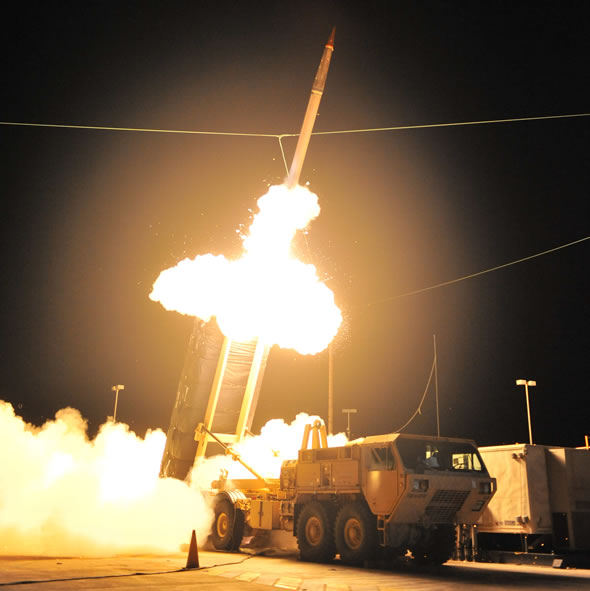Forget The B-2s Over Seoul, Pentagon Sent THAADs To Guam

In the past month, the Pentagon has sent everything from B-2s to nuclear submarines to the Korean Peninsula to remind North Korea who they’re dealing with. But for a more concerning sign that the Pentagon is taking the threat seriously, look to Guam.
***************************** ***************************
The Pentagon announced on Wednesday it was sending the mobile, land-based missile defense system THAAD (Terminal High Altitude Area Defense) to Guam. It’s the latest sign the U.S. believes North Korea may indeed launch a missile -- perhaps even a nuclear-tipped missile -- across the Western Pacific at a U.S. military target.
The truck-mounted missile system is designed to shoot down short- and medium-range ballistic missiles within 250 kilometers, serving as an umbrella system for large theaters of operation. It is also able to target missiles outside the atmosphere, giving it a higher range than the Patriot system.

THAAD Terminal High-Altitude Area Defence,
The U.S. Army Terminal High Altitude Area Defense (THAAD) missile system performed a successful intercept October 5, 2011, scoring simultaneous kills of two targets.
THAAD is designed to protect against incoming threats such as tactical and theatre ballistic missiles at ranges of 200km.
The THAAD missile uses kinetic energy, hit-to-kill technology.
But THAAD is yet another Pentagon missile defense system that defense and industry officials praise but arms critics shred as unreliable and unready for action. According to GlobalSecurity.org, only two of six planned batteries were certified for “initial operational capacity” in fiscal 2012, which is a lower state of readiness than “full operational capacity.” Further testing required by the Army’s own guidelines is scheduled into 2017, delaying “full material release” of the batteries to the Army.
“THAAD is operationally effective against short-range ballistic missile threats of the types tested through the end of 2012. It has not been demonstrated against medium-range threats,” the group found. But based on initial testing the group believes THADD is “likely” effective against medium-range missiles and is therefore “operationally suitable,” but “limited.”
Its deployment follows Hagel’s announcement that the Pentagon would spend $1 billion to increase the number of controversial ground-based interceptor (GBI) missiles based in Alaska, even though the last successful test of that system was in 2008.
A Pentagon statement described the decision to deploy THAAD to Guam as only “a precautionary move to strengthen our regional defense posture against the North Korean regional ballistic missile threat.”
But weapons guru John Pike, director of GlobalSecurity.org, said the THAAD system was still stuck somewhere in between test-phase and actual operational readiness. Pike said it reminded him of the 1950s when unproven nuclear bombs in the U.S. testing program were being classified as “EC” which stood for “emergency capability.”
“I think THAAD right now is an EC,” Pike said, in an interview. It’s a defense, he argued, that “had been known to work on occasions -- might work -- better safe than sorry, better something than nothing.”
By now, Pike said he is worried North Korea has painted itself into a corner situation where it must make good on its threats or risk losing face and credibility. Sending a nuclear bomb over Guam is not implausible, which makes the Pentagon’s decision to deploy the THAAD anti-missile system “only sensible.”
“Possession of nuclear weapons implies a willingness to use them,” Pike said. “If the North Korean leadership felt that a demonstration test against a military target would be of some value, an airburst over Guam would be on the short list.” An air burst is a detonation of a bomb in the air at altitude, rather than near or at ground level.
But Pike questioned why the Pentagon announcement said the mobile system would be deployed “in the coming weeks” when the North Korean threat seems imminent.
“I don’t understand what the hold-up is. The party’s going to be over by then,” he said. “I’d rather hear ‘in the coming days.’”
Defense officials would not elaborate on the timeline of THAAD’s arrival in Guam beyond the DOD statement, saying it was meant to be a vague window in order to mask the timeline of when then the system becomes operational on-site.
Still, Pike is watching westward, fearing something is coming the way of U.S. military bases.
“The North Koreans have run out of [non-] kinetic provocations, haven’t they? I mean, how many times can you declare war?” he said. “If they don’t start shooting within the next week or 10 days, everybody’s going to say they’re a bunch of chickens, that they can talk the talk but they’re not willing to walk the walk, aren't they? And they’re going to say of Kim Jong-Un, he don’t know how to run nothing but his mouth,” to paraphrase a classic Marion Barry quote.
But even for a hardware expert like Pike, the U.S. solution does not lie in deploying more weapons. South Korea and the Americans, he argued, “can take it up the escalation ladder as far as the North wants to go.” The thing that could change North Korea’s tune, he said, is China.
“The North would run out of rubble to bounce before the Americans would run out of hydrogen bombs.”
SOURCE: Foreign Policy
Tags:
"Destroying the New World Order"
THANK YOU FOR SUPPORTING THE SITE!
Latest Activity
- Top News
- ·
- Everything
THE GREAT FLOOD Official Trailer (2026) Netflix | Global Disaster Movies 4K
Mothman Prophecies
The 100 Series Designated for SAC and a Possible WWIII
Human Be-In - Full Program - 1/14/1967 - Polo Fields, Golden Gate Park (Official)
Sebastion Piñera and 5G
© 2025 Created by truth.
Powered by
![]()


